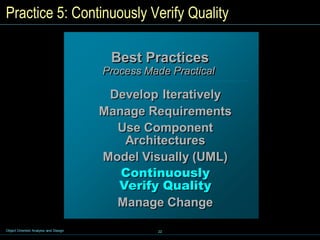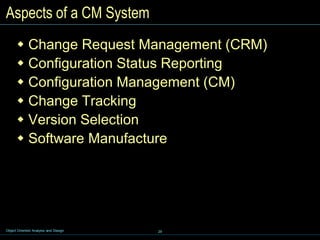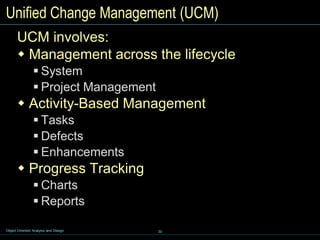Best Practices in Object Oriented Analysis and Design
- 1. Object-Oriented Analysis and Design Lecture 1: Best Practices of Software Engineering
- 2. 2 Object Oriented Analysis and Design Objectives Identify activities for understanding and solving software engineering problems. Explain the Six Best Practices. Present the Rational Unified Process (RUP) within the context of the Six Best Practices.
- 3. 3 Object Oriented Analysis and Design Content Outline Software development problems The Six Best Practices RUP within the context of the Six Best Practices
- 4. 4 Object Oriented Analysis and Design Symptoms of Software Development Problems User or business needs not met Requirements not addressed Modules not integrating Difficulties with maintenance Late discovery of flaws Poor quality of end-user experience Poor performance under load No coordinated team effort Build-and-release issues
- 5. 5 Object Oriented Analysis and Design Trace Symptoms to Root Causes Needs not met Requirements churn Modules don’t fit Hard to maintain Late discovery Poor quality Poor performance Colliding developers Build-and-release Insufficient requirements Ambiguous communications Brittle architectures Overwhelming complexity Undetected inconsistencies Poor testing Subjective assessment Waterfall development Uncontrolled change Insufficient automation Symptoms Root Causes Best Practices Ambiguous communications Undetected inconsistencies Develop Iteratively Manage Requirements Use Component Architectures Model Visually (UML) Continuously Verify Quality Manage Change Model Visually (UML) Continuously Verify Quality Modules do not fit
- 6. 6 Object Oriented Analysis and Design Content Outline Software development problems The Six Best Practices RUP within the context of the Six Best Practices
- 7. 7 Object Oriented Analysis and Design Best Practices Process Made Practical Develop Iteratively Manage Requirements Use Component Architectures Model Visually (UML) Continuously Verify Quality Manage Change Practice 1: Develop Iteratively
- 8. 8 Object Oriented Analysis and Design Waterfall Development Characteristics Delays confirmation of critical risk resolution Measures progress by assessing work products that are poor predictors of time-to- completion Delays and aggregates integration and testing Precludes early deployment Frequently results in major unplanned iterations Code and unit test Design Subsystem integration System test Waterfall Process Requirements analysis
- 9. 9 Object Oriented Analysis and Design Iterative Development Produces an Executable Initial Planning Planning Requirements Analysis & Design Implementation Deployment Test Evaluation Management Environment Each iteration results in an executable release
- 10. 10 Object Oriented Analysis and Design Risk Reduction Time Risk Waterfall Risk Iterative Risk Risk Profiles
- 14. 11 Object Oriented Analysis and Design Practice 2: Manage Requirements Best Practices Process Made Practical Develop Iteratively Manage Requirements Use Component Architectures Model Visually (UML) Continuously Verify Quality Manage Change
- 15. 12 Object Oriented Analysis and Design Requirements Management Making sure you solve the right problem build the right system by taking a systematic approach to eliciting organizing documenting managing the changing requirements of a software application.
- 16. 13 Object Oriented Analysis and Design Aspects of Requirements Management Analyze the Problem Understand User Needs Define the System Manage Scope Refine the System Definition Manage Changing Requirements
- 17. 14 Object Oriented Analysis and Design Problem Solution Space Problem Space Needs Features Software Requirements Test Scripts Design User Docs The Product to Be Built Map of the Territory
- 18. 15 Object Oriented Analysis and Design Practice 3: Use Component Architectures Best Practices Process Made Practical Develop Iteratively Manage Requirements Use Component Architectures Model Visually (UML) Continuously Verify Quality Manage Change
- 20. 16 Object Oriented Analysis and Design Resilient Component-Based Architectures Resilient Meets current and future requirements Improves extensibility Enables reuse Encapsulates system dependencies Component-based Reuse or customize components Select from commercially available components Evolve existing software incrementally
- 21. 17 Object Oriented Analysis and Design Purpose of a Component-Based Architecture Basis for reuse Component reuse Architecture reuse Basis for project management Planning Staffing Delivery Intellectual control Manage complexity Maintain integrity System- software Middleware Business- specific Application- specific Component-based architecture with layers
- 22. 18 Object Oriented Analysis and Design Practice 4: Model Visually (UML) Best Practices Process Made Practical Develop Iteratively Manage Requirements Use Component Architectures Model Visually (UML) Continuously Verify Quality Manage Change
- 23. 19 Object Oriented Analysis and Design Why Model Visually? Captures structure and behavior Shows how system elements fit together Keeps design and implementation consistent Hides or exposes details as appropriate Promotes unambiguous communication The UML provides one language for all practitioners
- 24. 20 Object Oriented Analysis and Design Visual Modeling With the Unified Modeling Language Activity Diagrams Models Dynamic Diagrams Static Diagrams Multiple views Precise syntax and semantics Sequence Diagrams Collaboration Diagrams Statechart Diagrams Deployment Diagrams Component Diagrams Object Diagrams Class Diagrams Use-Case Diagrams
- 25. 21 Object Oriented Analysis and Design Visual Modeling Using UML Diagrams Actor A Use Case 1 Use Case 2 Actor B user : Clerk mainWnd : MainWnd fileMgr : FileMgr repository : Repository document : Document gFile : GrpFile 9: sortByName ( ) L 1: Doc view request ( ) 2: fetchDoc( ) 5: readDoc ( ) 7: readFile ( ) 3: create ( ) 6: fillDocument ( ) 4: create ( ) 8: fillFile ( ) Window95 ¹®¼-°ü¸® Ŭ¶óÀ̾ðÆ®.EXE Windows NT ¹®¼-°ü¸® ¿£Áø.EXE Windows NT Windows95 Solaris ÀÀ¿ë¼-¹ö.EXE Alpha UNIX IBM Mainframe µ¥ÀÌŸº£À̽º¼-¹ö Windows95 ¹®¼-°ü¸® ¾ÖÇø´ Document FileManager GraphicFile File Repository DocumentList FileList user mainWnd fileMgr : FileMgr repository document : Document gFile 1: Doc view request ( ) 2: fetchDoc( ) 3: create ( ) 4: create ( ) 5: readDoc ( ) 6: fillDocument ( ) 7: readFile ( ) 8: fillFile ( ) 9: sortByName ( ) ƯÁ¤¹®¼-¿¡ ´ëÇÑ º¸±â¸¦ »ç¿ëÀÚ°¡ ¿äûÇÑ´Ù. È-ÀÏ°ü¸®ÀÚ´Â Àоî¿Â ¹®¼-ÀÇ Á¤º¸¸¦ ÇØ´ç ¹®¼- °´Ã¼¿¡ ¼³Á¤À» ¿äûÇÑ´Ù. È-¸é °´Ã¼´Â ÀоîµéÀÎ °´Ã¼µé¿¡ ´ëÇØ À̸§º°·Î Á¤·ÄÀ» ½ÃÄÑ È-¸é¿¡ º¸¿©ÁØ´Ù. Forward and Reverse Engineering Target System Openning Writing Reading Closing addfile[numberOffile==MAX]/ flagOFF addfile closefile closefile Use Case 3 Use-Case Diagram Class Diagram Collaboration Diagram Sequence Diagram Component Diagram Statechart Diagram GrpFile read( ) open( ) create( ) fillFile( ) rep Repository name : char * = 0 readDoc( ) readFile( ) (from Persistence) FileMgr fetchDoc( ) sortByName( ) DocumentList add( ) delete( ) Document name : int docid : int numField : int get( ) open( ) close( ) read( ) sortFileList( ) create( ) fillDocument( ) fList 1 FileList add( ) delete( ) 1 File read( ) read() fill the code.. Deployment Diagram
- 26. 22 Object Oriented Analysis and Design Practice 5: Continuously Verify Quality Best Practices Process Made Practical Develop Iteratively Manage Requirements Use Component Architectures Model Visually (UML) Continuously Verify Quality Manage Change
- 27. 23 Object Oriented Analysis and Design Continuously Verify Your Software’s Quality Cost Transition Construction Elaboration Inception Software problems are 100 to 1000 times more costly to find and repair after deployment Cost to Repair Software Cost of Lost Opportunities Cost of Lost Customers
- 29. 24 Object Oriented Analysis and Design Testing Dimensions of Quality Reliability Test that the application behaves consistently and predictably. Performance Test the online response under average and peak loading. Functionality Test the accurate workings of each usage scenario. Usability Test application from the perspective of convenience to end user. Supportability Test the ability to maintain and support application under production use.
- 30. 25 Object Oriented Analysis and Design UML Model and Implementation Tests Iteration 1 Test Suite 1 Iteration 2 Test Suite 2 Iteration 4 Test Suite 4 Iteration 3 Test Suite 3 Test Each Iteration
- 31. 26 Object Oriented Analysis and Design Test Within the Product Development Lifecycle Iteration X Iteration X + 2 Iteration X + 1 Requirements Capture Analysis and Design Implementation Time Project Planning Define Mission Build Test and Evaluate Validate Build Achieve Mission Improve Assets Verify Approach
- 32. 27 Object Oriented Analysis and Design Practice 6: Manage Change Best Practices Process Made Practical Develop Iteratively Manage Requirements Use Component Architectures Model Visually (UML) Continuously Verify Quality Manage Change
- 33. 28 Object Oriented Analysis and Design ALERT REPORT Workspace Management Process Integration Parallel Development Build Management Configuration Management is more than just check-in and check-out What Do You Want to Control? Secure workspaces for each developer Automated integration/build management Parallel development
- 34. 29 Object Oriented Analysis and Design Aspects of a CM System Change Request Management (CRM) Configuration Status Reporting Configuration Management (CM) Change Tracking Version Selection Software Manufacture
- 35. 30 Object Oriented Analysis and Design Unified Change Management (UCM) UCM involves: Management across the lifecycle System Project Management Activity-Based Management Tasks Defects Enhancements Progress Tracking Charts Reports
- 36. 31 Object Oriented Analysis and Design Best Practices Reinforce Each Other Validates architectural decisions early on Addresses complexity of design/implementation incrementally Measures quality early and often Evolves baselines incrementally Ensures users are involved as requirements evolve Best Practices Develop Iteratively Manage Requirements Use Component Architectures Model Visually (UML) Continuously Verify Quality Manage Change
- 37. 32 Object Oriented Analysis and Design Module 1 Content Outline Software development problems The Six Best Practices RUP within the context of the Six Best Practices
- 38. 33 Object Oriented Analysis and Design Rational Unified Process Implements Best Practices Best Practices Process Made Practical Develop Iteratively Manage Requirements Use Component Architectures Model Visually (UML) Continuously Verify Quality Manage Change
- 39. 34 Object Oriented Analysis and Design Achieving Best Practices Iterative approach Guidance for activities and artifacts Process focus on architecture Use cases that drive design and implementation Models that abstract the system
- 40. 35 Object Oriented Analysis and Design A Team-Based Definition of Process A process defines Who is doing What, When, and How, in order to reach a certain goal. New or changed requirements New or changed system Software Engineering Process
- 41. 36 Object Oriented Analysis and Design Inception Elaboration Construction Transition Process Structure - Lifecycle Phases Rational Unified Process has four phases: Inception - Define the scope of project Elaboration - Plan project, specify features and baseline architecture Construction - Build the product Transition - Transition the product into end-user community time
- 42. 37 Object Oriented Analysis and Design Phase Boundaries Mark Major Milestones Inception Elaboration Construction Transition Lifecycle Objective Milestone (LCO) Lifecycle Architecture Milestone (LCA) Initial Operational Capability Milestone (IOC) Product Release time
- 43. 38 Object Oriented Analysis and Design Iterations and Phases An iteration is a distinct sequence of activities based on an established plan and evaluation criteria, resulting in an executable release (internal or external). Preliminary Iteration Architect. Iteration Architect. Iteration Devel. Iteration Devel. Iteration Devel. Iteration Transition Iteration Transition Iteration Inception Elaboration Construction Transition Minor Milestones: Releases
- 45. 39 Object Oriented Analysis and Design Bringing It All Together: The Iterative Approach Disciplines group activities logically. In an iteration, you walk through all disciplines.
- 46. 40 Object Oriented Analysis and Design Disciplines Produce Models Realized By Implementation Model Design Model Use-Case Model Models Disciplines Implement- ation Analysis & Design Require- ments Business Use- Case Model Business Modeling Business Object Model B B B B Realized By Automated By Implemented By
- 47. 41 Object Oriented Analysis and Design Disciplines Guide Iterative Development Business Modeling: Workflow Requirements: Workflow
- 48. 42 Object Oriented Analysis and Design Overview of Rational Unified Process Concepts Phase Iteration Discipline Workflow Detail Role Artifact Activity Divided into Considers Described by Responsible for Modifies References Participates in Document Model Element Model
- 49. 43 Object Oriented Analysis and Design Review Best Practices guide software engineering by addressing root causes. Best Practices reinforce each other. Process guides a team on who does what, when, and how. The Rational Unified Process is a means of achieving Best Practices.









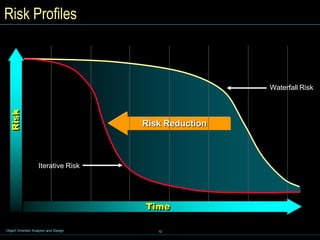











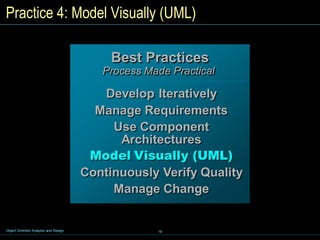


![21
Object Oriented Analysis and Design
Visual Modeling Using UML Diagrams
Actor A
Use Case 1
Use Case 2
Actor B
user : Clerk
mainWnd : MainWnd
fileMgr : FileMgr
repository : Repository
document : Document
gFile : GrpFile
9: sortByName ( )
L
1: Doc view request ( )
2: fetchDoc( )
5: readDoc ( )
7: readFile ( )
3: create ( )
6: fillDocument ( )
4: create ( )
8: fillFile ( )
Window95
¹®¼-°ü¸®
Ŭ¶óÀ̾ðÆ®.EXE
Windows
NT
¹®¼-°ü¸® ¿£Áø.EXE
Windows
NT
Windows95
Solaris
ÀÀ¿ë¼-¹ö.EXE
Alpha
UNIX
IBM
Mainframe
µ¥ÀÌŸº£À̽º¼-¹ö
Windows95
¹®¼-°ü¸® ¾ÖÇø´
Document
FileManager
GraphicFile
File
Repository DocumentList
FileList
user
mainWnd fileMgr :
FileMgr
repository
document :
Document
gFile
1: Doc view request ( )
2: fetchDoc( )
3: create ( )
4: create ( )
5: readDoc ( )
6: fillDocument ( )
7: readFile ( )
8: fillFile ( )
9: sortByName ( )
ƯÁ¤¹®¼-¿¡ ´ëÇÑ º¸±â¸¦
»ç¿ëÀÚ°¡ ¿äûÇÑ´Ù.
È-ÀÏ°ü¸®ÀÚ´Â Àоî¿Â
¹®¼-ÀÇ Á¤º¸¸¦ ÇØ´ç ¹®¼-
°´Ã¼¿¡ ¼³Á¤À» ¿äûÇÑ´Ù.
È-¸é °´Ã¼´Â ÀоîµéÀÎ
°´Ã¼µé¿¡ ´ëÇØ À̸§º°·Î
Á¤·ÄÀ» ½ÃÄÑ È-¸é¿¡
º¸¿©ÁØ´Ù.
Forward and
Reverse
Engineering
Target
System
Openning
Writing
Reading
Closing
addfile[numberOffile==MAX]/
flagOFF
addfile
closefile
closefile
Use Case 3
Use-Case
Diagram
Class Diagram
Collaboration
Diagram
Sequence
Diagram
Component
Diagram
Statechart
Diagram
GrpFile
read( )
open( )
create( )
fillFile( )
rep
Repository
name : char * = 0
readDoc( )
readFile( )
(from Persistence)
FileMgr
fetchDoc( )
sortByName( )
DocumentList
add( )
delete( )
Document
name : int
docid : int
numField : int
get( )
open( )
close( )
read( )
sortFileList( )
create( )
fillDocument( )
fList
1
FileList
add( )
delete( )
1
File
read( )
read() fill the
code..
Deployment
Diagram](https://image.slidesharecdn.com/slide01bestpractices-240311115345-8baafe7e/85/Best-Practices-in-Object-Oriented-Analysis-and-Design-25-320.jpg)
